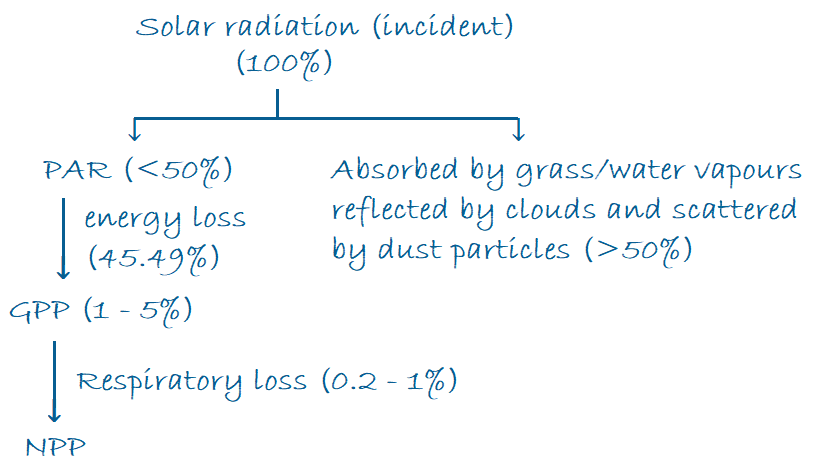Ecosystem
Energy flow; pyramids of number, biomass, energy
- Sun (incident solar radiation) is the ultimate source of energy in all ecosystem. (100%).
- Photosynthetically Active Radiation (PAR) is less than 50% of solar radiation under optimum condition only a very small portion, about 5% of incoming rediation (10% PAR) is converted in photosynthesis into gross primary productivity (GPP).
- The flow of energy in an ecosystem is always unidirectional

- Energy in ecosystem is based on 1st and 2nd law of thermodynamics. 1st law of thermodynamics states that energy is neither created nor destroyed, but can be transferred from one component to another, or transformed from one state to another (solar energy is transformed into energy of food by autotrophs).
- 2nd law of thermodynamics states that energy transformation involves degradation (or) dissipiation of energy from a concentrated to a dispersed from due to metabolic functions, so that only a small part of energy is stored in the biomass.
- An ecological pyramid is graphical representation of relationship between individuals present in various trophic levels of food chain with producers from the base and top carnivores the tip. It can be upright, inverted / spindle shape.
- The concept of ecological pyramid was developed by charlselton (1927) hence they are also called as eltonian pyramids.
- Ecological pyramids are of three types
(i) Pyramid of number
(ii) Pyramid of biomass
(iii) Pyramid of energy - Pyramid of number shows the number of individual organisms at each level. It may be upright, inverted or spindle shaped. Pyramid of number becomes spindle shaped for d tree as herbivorous birds are usually eaten by eagle / falcon.
- Pyramid of biomass showing the total dry weight and other suitable measures of total amount of the living matter. It is upright for tree and grassland ecosystem and inverted in acquatic ecosystem.
- Pyramid of energy shows the rate of energy flow and productivity at successive trophic levels. Pyramid of energy is always upright because the flow of energy is unidirectional from producer to consumer level.
- In parasitic food chain, the pyramid of number is always inverted. This is due to the fact that a single plant may support the growth of many herbivores and each herbivore support many hyper parasites.
- In pond ecosystem, the producers are small organisms their biomass is the least, and this value gradually shows an increase towards the apex of the pyramid thus making the pyramid of biomass inverted in shape.
Disclaimer: Compete.etutor.co may from time to time provide links to third party Internet sites under their respective fair use policy and it may from time to time provide materials from such third parties on this website. These third party sites and any third party materials are provided for viewers convenience and for non-commercial educational purpose only. Compete does not operate or control in any respect any information, products or services available on these third party sites. Compete.etutor.co makes no representations whatsoever concerning the content of these sites and the fact that compete.etutor.co has provided a link to such sites is NOT an endorsement, authorization, sponsorship, or affiliation by compete.etutor.co with respect to such sites, its services, the products displayed, its owners, or its providers.

